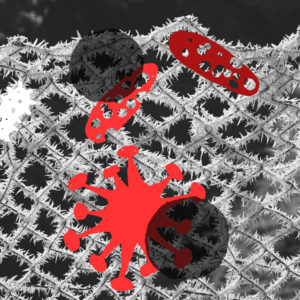Dr Barbara Brockway provides an in-depth article on the colonization of the skin microbiome, a process starting from birth, and how the increased understanding of our unique microbiome may mean that our perception of human health may never be the same.
Introduction
The microbiome is the next scientific area to make a profound impact on all our lives. Major breakthroughs in DNA technology, proteomics, metabolomic* studies and initiatives such as the Human Microbiome Project (HMP), have led to remarkable new methods. One example is next-generation sequencing (NGS) technologies and, in particular, targeted amplicon sequencing of the 16S ribosomal RNA gene (16S-seq). These are enabling the identification and quantification of the thousands of different microbes living in and on our bodies – our human microbiota.

“Our 1.8 m2 skin includes vast numbers of diverse habitats.”
These new technologies are showing a previously unseen world and exposing, rather spectacularly, the failings of traditional culture methods, which missed the hundreds of microbes that resist isolating and culturing because they need other microorganisms to be present to live or because they are too few to feature. Scientists in the past were misled into thinking the skin was home to a relatively few ”good or bad” microbial species, which should either be encouraged or removed. Thanks to recent discoveries, today’s researchers appreciate how all these microbes are needed to maintain the complexity of healthy microbial communities. The talk of ”good and bad” microbes is no longer relevant and thus fading from the conversation. The latest culture-independent techniques are enabling the skin’s complex microbial communities to be mapped out in virtual high definition and their results are truly game-changing.
Our 1.8 m2 of skin includes vast numbers of diverse habitats. There are large expanses of dry surfaces, oily sebaceous glands and dark deep rooted hair follicles. Skin has millions of fine lines, wrinkles, folds, invaginations and specialized niches so it is not surprising we are discovering our skin supports hundreds of different types of microbes.
The birth and survival of skin microbiota
Skin microbiota is acquired sequentially starting at birth and, fascinatingly, there is a marked difference in skin microbiota between babies who experience vaginal birth and those delivered by caesarean section. Vaginal bacteria such as Lactobacillus, Prevotella and Sneathia are the first to colonize vaginally-delivered babies whereas those delivered by caesarean-section have their skin colonized by an assortment of microbes, which are mainly from the mother’s skin – often including Propionibacterium, Staphylococcus and Corynebacterium.
The diversity of microbes colonizing babies’ skin, regardless of how they are first colonized, gradually increases with age. Our skin is generally hostile to most microbes so although babies’ skin is continually exposed to new microbes, only a few species which can cope with relatively dry environments – or with the moist, sweaty areas – can become primary colonizers. The most successful primary microbes are those able to live at low pH with widely fluctuating surface temperatures. They also need to be able to cope with the high osmotic pressures that are produced when sweat evaporates and then concentrates into dissolved salts. Once established, these air-loving and air-tolerating microbes begin to subtly change the local, host environments. They reduce the local oxygen levels and produce substances, such as biofilms, that enable the various secondary colonizers to join them. Because nutrients are limited to mainly salts, proteins, lipids and materials from the already established microbes, this nascent ecosystem is quite exclusive. This developing skin microbiota prevents many other microbes from adhering and so begins to create a defensive shield. Skin microbiota soon develops into a multitude of interdependent climax communities, which are stabilized by complex nutritional interactions (food webs) and also by a kind of natural germ warfare, where microbes produce molecules such as acids, enzymes and bacteriocins that are ‘unfriendly’ or even deadly to other microbes.
An interdependent community of microbes
The precise composition of an individual’s skin microbiota depends on so many variables such as gender, diet, health, climate, personal hygiene and lifestyle, including exposure to pets. By way of examples, changes in skin due to sexual maturity in young adults encourages increasing proportions of Corynebacterium and Propionibacterium.
Culture-independent analysis of the human skin microbiome shows our skin hosts more than 350 different microbial species belonging to over 200 different genera. To date, 19 bacterial phyla have been identified in skin microbiota although it is dominated by four phyla: Actinobacteria, Firmicutes, Proteobacteria, Bacteroidetes. The three genera, Staphylococcus, Corynebacterium and Propionibacterium, account for more than 60% of the bacterial species present. Archaea, which are more closely related to animal, yeast and plant cells than to bacteria, comprise up to 4.2% of the skin microbiome and are mainly Thaumarchaeota (ammonia-oxidisers)[1].
 As stated previously, it is now widely accepted that most microbes in the human microbiota, are not simply ”good or bad” but are rather, essential members of a complex interdependent community living in harmony with our cells. Some microbes simply benefit from being part of our skin microbiota without harming us, while others work together with our cells as mutual partners, where, for example, in return for nutrients (or for some other benefits) they thrive and some secrete biochemicals that help prevent pathogens from becoming established. Results are showing that greater biodiversity in skin microbiotas is, in fact, important and desirable. Combinations of many different microbes are better able to adapt with the natural ”ebb and flow” of changing local conditions but, more importantly, greater biodiversity protects us from skin problems due to opportunistic pathogens such as Staphylococcus aureus, that become established and flourish causing an imbalance in the microbiota (dysbiosis).
As stated previously, it is now widely accepted that most microbes in the human microbiota, are not simply ”good or bad” but are rather, essential members of a complex interdependent community living in harmony with our cells. Some microbes simply benefit from being part of our skin microbiota without harming us, while others work together with our cells as mutual partners, where, for example, in return for nutrients (or for some other benefits) they thrive and some secrete biochemicals that help prevent pathogens from becoming established. Results are showing that greater biodiversity in skin microbiotas is, in fact, important and desirable. Combinations of many different microbes are better able to adapt with the natural ”ebb and flow” of changing local conditions but, more importantly, greater biodiversity protects us from skin problems due to opportunistic pathogens such as Staphylococcus aureus, that become established and flourish causing an imbalance in the microbiota (dysbiosis).
Some Staphylococcus aureus strains are particularly potent. They produce toxins and cell-surface proteins that bind and inactivate antibodies and yet, despite their capacity to be harmful, they can live harmlessly in biodiverse microbiota communities. The degree of diversity and the interdependence between our cells and the microbiota go a long way to explain paradoxes such as why Staphylococcus aureus causes atopic dermatitis in some individuals and not in others. Or why acne becomes a significant problem mainly at specific times in an individual’s development and never a problem to others, even though everyone has Propionibacterium acnes living in the oily region of their skin. Similarly, it explains why we do not all suffer from dandruff yet the fungus responsible for dandruff, Malassezia globosa, is found on everyone’s scalp.
Although it is commonly agreed that greater biodiversity in skin microbiota is a good thing, there is no consensus on how diversity in the microbiome is defined or determined. Several diversity indices that were originally designed for macroecology are being used, however, none are ideal as they do not compensate for bias in the different approaches to sequencing. Also, there is still a place for culture techniques in the study of microbiota biodiversity, as DNA from viable and dead cell debris will be indistinguishably sequenced.
“From the beauty and health industries perspective we really are entering new and fertile territory.”
A quest to rebalance the microbiota
From the beauty and health industries perspective, we really are entering the new and fertile territory. We know that germ-free animals are notoriously fragile with decreased immune resistance to infection and elevated stress response, which results in weaker populations with higher death rates. We, therefore, should not undervalue the part the microbiota plays in keeping us healthy.
As there is no single, ideal microbiota to strive for, the focus can turn to develop products to protect and perhaps gently rebalance the skin microbiota communities that are in danger of entering dysbiosis. Most research to date has been on the gut microbiome where we are learning of connections between the depletion of certain gut microbes and inflammatory diseases. Clinicians are also finding that success or failure of therapy can be due to how drugs are metabolized by the gut microbiota. Cosmetic product developers should look closely at these findings and see if there are parallels with the behaviour of skin microbiota. There is so much to discover and perhaps we should start first by learning how current cosmetic products and practices affect skin’s microbiome.
Finally, it is well worth mentioning that we all have a very personalized skin microbiota. The exact composition of an individual’s microbiome is determined by so many variables, from the complex interplay between us and the many microbes in our skin microbiota to external influences due to lifestyle or our environment. Together these influences ensure our microbiome is unique. This uniqueness has attracted the interest of forensic scientists, as traces of skin microbiome left at a crime scene can be used, alongside forensic DNA analysis of human DNA, to identify a person or give clues to their lifestyles. Our unique microbiomes can even distinguish between identical twins living in the same home.
Our understanding of the microworld has come a long very way since the microscope first showed that the Roman idea of invisible, minute animals was real, and since 19th-century scientists hunted down the microbes responsible for infectious disease. Now NGS creates ‘microbiome-selfies’ with relative ease, and paradoxes can be explained. Never again will we undervalue the part the microbiota plays in keeping us healthy and consequently appreciate the importance of keeping our microbiota healthy.
* Metabolomics: the scientific study of the set of metabolites presents within an organism, cell, or tissue.
Read more about us here and see our Instagram here.
References:
[1] The Human Microbiota in Health and Disease: An Ecological and Community-based Approach. 1st Edition. Michael Wilson. Published 10 September 2018.